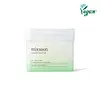Troubless Clear Toner Pad Versus Mixsoon Toner Pad
What's inside
What's inside
 Key Ingredients
Key Ingredients

 Benefits
Benefits

 Concerns
Concerns

No concerns
 Ingredients Side-by-side
Ingredients Side-by-side

Water
Skin ConditioningDipropylene Glycol
HumectantButylene Glycol
HumectantMethylpropanediol
SolventC12-14 Pareth-12
EmulsifyingSodium Citrate
BufferingHydroxyacetophenone
AntioxidantBetaine
HumectantCaprylyl Glycol
EmollientGluconolactone
Skin ConditioningGlycolic Acid
BufferingEthylhexylglycerin
Skin ConditioningHydroxyethylcellulose
Emulsion Stabilising1,2-Hexanediol
Skin ConditioningGlycerin
HumectantSodium Hyaluronate
HumectantMelaleuca Alternifolia Leaf Oil
AntioxidantCapryloyl Salicylic Acid
Exfoliating4-Terpineol
MaskingPinus Pinaster Leaf Extract
Skin ConditioningOenothera Biennis Flower Extract
AstringentUlmus Davidiana Root Extract
Skin ConditioningPueraria Lobata Root Extract
HumectantSprout Extract
AntioxidantCamellia Sinensis Leaf Extract
AntimicrobialDipotassium Glycyrrhizate
HumectantSalix Alba Bark Extract
AstringentSalicylic Acid
MaskingGardenia Florida Seed Extract
Skin ConditioningBrassica Oleracea Italica Extract
AstringentDextrin
AbsorbentDisodium EDTA
Water, Dipropylene Glycol, Butylene Glycol, Methylpropanediol, C12-14 Pareth-12, Sodium Citrate, Hydroxyacetophenone, Betaine, Caprylyl Glycol, Gluconolactone, Glycolic Acid, Ethylhexylglycerin, Hydroxyethylcellulose, 1,2-Hexanediol, Glycerin, Sodium Hyaluronate, Melaleuca Alternifolia Leaf Oil, Capryloyl Salicylic Acid, 4-Terpineol, Pinus Pinaster Leaf Extract, Oenothera Biennis Flower Extract, Ulmus Davidiana Root Extract, Pueraria Lobata Root Extract, Sprout Extract, Camellia Sinensis Leaf Extract, Dipotassium Glycyrrhizate, Salix Alba Bark Extract, Salicylic Acid, Gardenia Florida Seed Extract, Brassica Oleracea Italica Extract, Dextrin, Disodium EDTA
Ingredients Explained
These ingredients are found in both products.
Ingredients higher up in an ingredient list are typically present in a larger amount.
1,2-Hexanediol is a synthetic liquid and another multi-functional powerhouse.
It is a:
- Humectant, drawing moisture into the skin
- Emollient, helping to soften skin
- Solvent, dispersing and stabilizing formulas
- Preservative booster, enhancing the antimicrobial activity of other preservatives
Betaine is a common humectant (a substance that promotes retention of moisture). It's known to be gentle on the skin and can help balance hydration.
This ingredient is best for improving hydration and soothing irritated skin. Studies also show it helps even out skin tone.
Fun fact: Betaine is naturally created in the skin and body. The kind found within cosmetic products can be either plant-derived or synthetic.
Another name for betaine is trimethylglycine.
Learn more about BetaineButylene Glycol (or BG) is used within cosmetic products for a few different reasons:
Overall, Butylene Glycol is a safe and well-rounded ingredient that works well with other ingredients.
Though this ingredient works well with most skin types, some people with sensitive skin may experience a reaction such as allergic rashes, closed comedones, or itchiness.
Learn more about Butylene GlycolDipropylene Glycol is a synthetically created humectant, stabilizer, and solvent.
This ingredient helps:
Dipropylene glycol is technically an alcohol, but it belongs to the glycol family (often considered part of the ‘good’ alcohols). This means it is hydrating and gentle on skin unlike drying solvent alcohols like denatured alcohol.
As a masking agent, Dipropylene Glycol can be used to cover the smell of other ingredients. However, it does not have a scent.
Studies show Dipropylene Glycol is considered safe to use in skincare.
Learn more about Dipropylene GlycolEthylhexylglycerin (we can't pronounce this either) is commonly used as a preservative and skin softener. It is derived from glyceryl.
You might see Ethylhexylglycerin often paired with other preservatives such as phenoxyethanol. Ethylhexylglycerin has been found to increase the effectiveness of these other preservatives.
Glycerin is already naturally found in your skin. It helps moisturize and protect your skin.
A study from 2016 found glycerin to be more effective as a humectant than AHAs and hyaluronic acid.
As a humectant, it helps the skin stay hydrated by pulling moisture to your skin. The low molecular weight of glycerin allows it to pull moisture into the deeper layers of your skin.
Hydrated skin improves your skin barrier; Your skin barrier helps protect against irritants and bacteria.
Glycerin has also been found to have antimicrobial and antiviral properties. Due to these properties, glycerin is often used in wound and burn treatments.
In cosmetics, glycerin is usually derived from plants such as soybean or palm. However, it can also be sourced from animals, such as tallow or animal fat.
This ingredient is organic, colorless, odorless, and non-toxic.
Glycerin is the name for this ingredient in American English. British English uses Glycerol/Glycerine.
Learn more about GlycerinWater. It's the most common cosmetic ingredient of all. You'll usually see it at the top of ingredient lists, meaning that it makes up the largest part of the product.
So why is it so popular? Water most often acts as a solvent - this means that it helps dissolve other ingredients into the formulation.
You'll also recognize water as that liquid we all need to stay alive. If you see this, drink a glass of water. Stay hydrated!
Learn more about Water